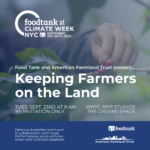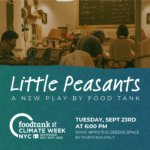R&DE Stanford Dining has joined Drawdown Labs, a consortium of private sector partners working to scale climate solutions. Stanford Dining is the first university-based member and the first foodservice organization to be part of Drawdown Labs’ network of bold business leaders taking accelerated climate action. Led by Project Drawdown—which aims to help the world achieve drawdown, the point in the future when greenhouse gas emissions stop increasing and start decreasing—Drawdown Labs now includes 14 organizations, from Google and Impossible Foods to Netflix and General Mills.
Stanford Dining joining Drawdown Labs is important for several reasons. First, it reflects the unique ability of campus dining programs as a critical, untapped lever for scaling climate solutions:
- through the bold campus sustainability goals these large foodservice operations have;
- through their substantial institutional purchasing power (colleges and universities have the total purchasing power of all chain restaurants);
- by influencing students’ food identities and preferences for years to come, as students will consume billions of meals throughout their lifetimes.
“As we work closely with universities across the world, we have a common core belief that students are the best and most powerful way forward towards creating a healthier, more sustainable future,” said Eric Montell, Executive Director of R&DE Stanford Dining. “To provide perspective in terms of Stanford students, we are serving over 3 million meals each year. That is a lot of meals that are being provided to students each year, and these meals are delicious, healthy, and sustainable, and impact students’ food choices while at Stanford. However, if you look at the amount of meals these same students will consume over their collective lifetimes, it is a surprising 200 million meals! We also know that our students will be tomorrow’s leaders, many will create their own companies that may include robust food programs for their staff, and they will also be parents. This means the number of meals they influence is exponentially more than the 200 million meals they will individually consume. If you multiply this across the entire campus dining sector, then it’s billions of future meals.”
Second, Stanford Dining’s membership in Drawdown Labs reflects an open invitation to other visionary leaders in foodservice to utilize the strategies presented by Project Drawdown and the importance of food systems change as one of the most effective solutions for reversing global warming. Food systems account for about a third of all greenhouse gas emissions globally. Stanford Dining is focusing on the often overlooked impact of food-related solutions for tackling the climate crisis. Project Drawdown ranks food waste reduction the number one solution for reversing global warming out of a growing list of over 80 solutions, including the usual focus areas from the energy and transportation sectors. Plant-rich diets are also ranked number three in Project Drawdown’s list of most impactful solutions. This is precisely why we and the The Culinary Institute of America co-lead the Menus of Change University Research Collaborative, a global network of 270 forward-thinking scholars, foodservice leaders, executive chefs, and administrators from over 60 colleges and universities, and our focus is on research, education, and innovation specifically to reduce food waste and advance plant-forward diets.
Stanford Dining learns from and contributes to transformative initiatives such as the MCURC’s Collective Impact Initiative, which has a collective target across all member institutions to reduce food-related greenhouse gas emissions (GHGE) by 25 percent by 2030. Our most recent work on our respective campuses was synthesized in the publication, “2020 MCURC Collective Impact Early Learnings Report,” which can help any foodservice leader reach similar targets for reducing GHGE.
Stanford Dining is building on its long-standing sustainability initiatives of reducing food waste by committing to further reduce our food waste by 25 percent by the end of 2022. Our partnership in Drawdown Labs will help us learn and shape not only long-term food waste targets but broader food-related climate targets over the months to come. Stanford Dining has also recently joined REGEN1, a consortium of food system leaders in Northern California supporting farmers who are employing regenerative agriculture principles that improve air, water, and soil quality, enhance biodiversity, and prioritize greater inclusion and equity for all.
“Sustainability is a core value for Residential & Dining Enterprises (R&DE),” said Dr. Shirley Everett, Senior Associate Vice Provost, Residential & Dining Enterprises, Stanford University.” As leaders, we are committed to service excellence in all of our operations. We are focused on preserving our planet, which includes continually implementing policies and practices that preserve our natural resources and reduce our overall impact on the environment. Through a number of strategic projects and programs, R&DE is integrating long-term sustainable initiatives into how we operate across the campus to provide enhanced ecological offerings to our valued students and customers.”
Our impact on regional food systems throughout Northern California and more broadly throughout the global network of suppliers within our purchasing network is vast. Stanford Dining is uniquely positioned to act as a leader in college and university foodservice—and even institutional foodservice at large, from K-12 schools to corporate dining, hospitals to nursing homes—with respect to scaling climate solutions because of its long history of pioneering new ways of effecting change in support of sustainable food systems. As co-founder of the MCURC, Stanford Dining has been working with food leaders in both academia and dining operations to push the boundaries of sustainability since the Collaborative’s inception in 2014.
Montell explains, “Our approach to climate-smart dining is rooted in the resounding message from climate scientists that our actions to address the climate emergency must be exponential in nature; we are past the time when incremental change is enough. University dining programs can be at the forefront of making change and be a key vehicle for climate action. It’s not just about the work we do as individual operators, but about how we work collectively with students to reduce our climate impact. We educate students about the EAT-Lancet report on food, planet, and health, which clearly shows how the health and environmental impacts of foods are linked together. The food system accounts for 37 percent of all carbon emissions and yet 90 percent of all countries in the Paris Climate Accord fail to take a food system approach to reduce their carbon emissions. Students can reshape the political willpower and create better opportunities towards climate action.”
So, however big or small, whether you’re in a position to influence a fellow campus dining program or any other institution—a school, an employer, a hospital system—join us in responding to this urgent call to action. We know from scientists like those at Project Drawdown that in principle the solutions are at our fingertips. Now it’s up to every foodservice leader out there to seize this call to action and put these ideas into practice. As the UN Secretary-General Ban Ki-moon said in 2013 at Stanford University: “There can be no Plan B because there is no planet B.”














